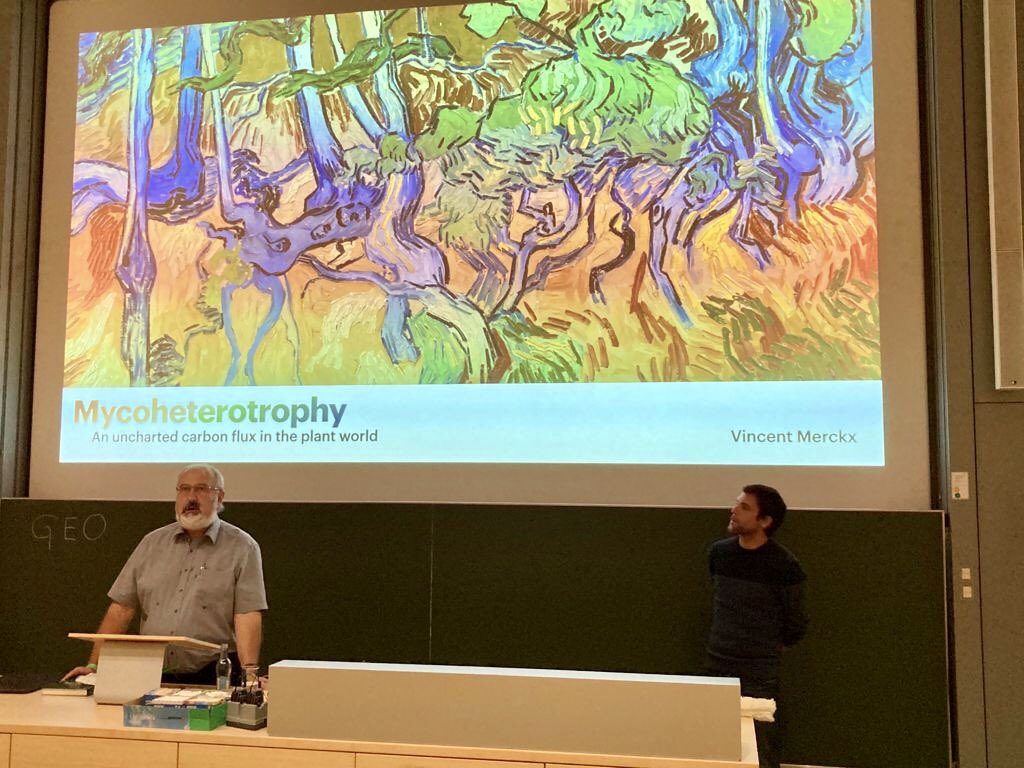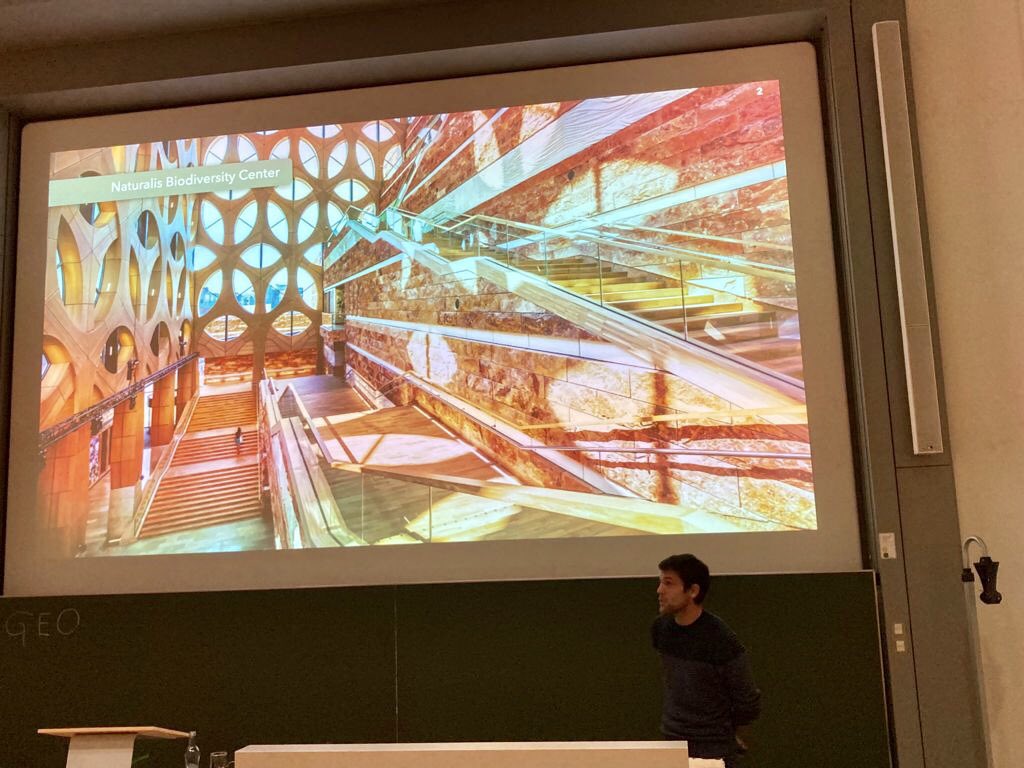Meet the Fellow: Vincent Merckx
Carbon transfer in arbuscular mycorrhizal networks
Although the pandemic slowed down the collaboration project of Dr. Vincent Merckx with his hosts at UBT, Prof. Dr. Gerhard Gebauer, Isotope Biogeochemistry, and Prof. Dr. Johanna Pausch, Agroecology, it could not prevent them from carrying out
effective preparatory work through virtual meetings. Finally, Dr. Merckx visited UBT in October 2021 and was happy to hold an in-person talk at the BayCEER Colloquium.

What are the foci of your joint research funded by the Fellowship?
Vincent Merckx: Our joint research focuses on mycoheterotrophy: the ability of plants to take up carbon from root associated fungi. Generally, plants are autotrophic organisms: they perform photosynthesis and use sunlight to fix carbon into organic compounds, such as sugars. Some plants, however, have evolved a strategy to take up these organic compounds from root associated fungi instead of performing photosynthesis: fully mycoheterotrophic plants. These plants mostly live in the understory of forests where there is insufficient light for photosynthetic plants to grow. There are only a few hundred of fully mycoheterotrophic plants. Hence, this mode of life has always been considered to be an exception in the forests around the world. Yet, their existence led to the discovery of partially mycoheterotrophic plants: plants that can combine photosynthesis with mycoheterotrophy. Thanks to our joint research, we now have data which advance the hypothesis that partially mycoheterotrophy might be widespread and very common among land plants. To our surprise, partial mycoheterotrophy was subsequently detected not in a remote rain forest, but in a ‘next door’ forest in Bavaria! Our research discoveries were only possible because of collaboration: plant collection and fungal analyses by the team of Dr. Merckx, and the stable isotope measurements and expertise of the team of Prof. Gebauer. To take the next step, we expanded the team with Prof. Pausch (UBT) for carbon tracer experiments, and Dr. Gomes (Leiden University) for the impact of our work on forest functioning.
Gerhard Gebauer: As already mentioned by Dr. Merckx, mycoheterotrophy is by far not limited to fungi forming ectomycorrhizas and representatives of the Orchidaceae and Ericaceae. Many fully mycoheterotrophic plants from other taxonomic groups and forming arbuscular mycorrhizas with Glomeromycotina are known from the tropics. Our collaboration with Dr. Merckx and his team was an important fundament for our recent discovery of partial mycoheterotrophy also among arbuscular mycorrhizal plants in temperate European forests. One of these partially mycoheterotrophic plants with arbuscular mycorrhiza is Herb Paris (Paris quadrifolia), recently chosen by the Loki-Schmidt-Foundation as flower of the year 2022 in Germany.
Johanna Pausch: The research of my group concentrates on carbon fluxes in the plant-soil system. Similar to Prof. Gebauer's group, we also use stable isotopes for process characterization and quantification of C-fluxes in plants and soils. However, the focus of my group is more on the application of stable isotopes in tracer experiments, which complements Prof. Gebauer's expertise in natural isotope abundance very well. Now, as part of the Fellowship, we will combine both isotope technologies with the molecular biology expertise of Dr. Merckx and Dr. Gomes to discover nutritional specialists among the plants that live in symbiosis with Glomeromycotina fungi. I am very excited about the collaboration with Dr. Merckx, Dr. Gomes and Prof. Gebauer within this project. It will nicely complement ongoing work in my group on the role of mycorrhizal fungi for soil carbon cycling and help to further extend our work from agroecosystems to natural ecosystems. In turn, by using isotope tracer experiments, this collaboration will yield new insights in C flux between individual plants via the fungal network.
In what way is your work interdisciplinary, and what does interdisciplinarity mean to you in academic work and life?
VM: Our work is a nice example of how each discipline provides a piece of the puzzle. By combining insights from each discipline, we are able to see the complete picture. Interdisciplinarity is very important for me, not only because it allows to address challenges from different angles, but also because it means working with different experts, each with a different approach and reasoning.
GG: Our shared project is an ideal example for interdisciplinary collaboration. It brings together expertise in molecular ecological approaches to identify the fungi involved in belowground plant-fungal networks by Dr. Merckx and in stable isotope biogeochemistry to elucidate carbon fluxes between fungi and plants under field conditions by myself. It is complemented by the expertise of Prof. Pausch in laboratory carbon-labelling experiments. Thanks to the collaboration with Dr. Gomes, it also addresses potential impacts of mycoheterotrophy on forest functioning.
JP: In addition to the expertise in the application of various methods that my colleagues have already outlined, I also see the interdisciplinary perspective on ecosystem processes as a major added value for the project. Thus, in the project we combine approaches from the fields of plant, fungal and soil ecology.

What is in your opinion the future of your field(s) / in what way can research in your field(s) contribute to meeting the urgent challenges of our time?
VM: Our research contributes to providing a better understanding of how our ecosystems work. Healthy ecosystems provide essential services to mankind and safeguard biodiversity. Therefore, I think my research field is a crucial component for addressing the challenges ahead. We still know little about how species interact, and how these interactions contribute to the stability of ecosystems and their resilience to global change.
GG: Our investigations are undoubtedly in the first instance basic research in order to improve our understanding of forest ecosystem functioning. A deeper knowledge on forest functioning, however, is also crucial for applied disciplines, like improved forest management, plant and fungi species conservation and maintenance of biodiversity.
JP: As large reservoirs for organic carbon, soils play an important role in climate change. In this context, the interaction between plants and soil organisms is critical. We now know that plants can provide energy to soil microorganisms by releasing carbon compounds through their roots into the soil, which in turn drives soil nutrient cycling. Much less is known about carbon fluxes from one to another plant via fungal networks. This is, however, a very exciting and so far largely unexplored area of research and can help to better understand the complexity of the ecosystem as a whole.
What does international research mobility mean to you?
VM: Research thrives on international mobility, and my research is no exception: to study mycoheterotrophy I have travelled to all major rainforest areas on earth and collaborated with researchers from all continents. I have worked in Belgium, USA, and the Netherlands. This has truly enriched me as a person and as a scientist on many levels. It is really depressing to see how nationalism (e.g. Brexit, the Trump administration) has made it more difficult for scientists to freely move around. My hope is that the current trend will be reversed; we have to stick together to effectively deal with the future challenges.
GG: International mobility as well as international collaborations are essential for our research. Mycoheterotrophic plants and their associated fungi are distributed in forests all over the world. We need unrestricted international mobility and close collaboration of researchers to further elucidate their secret ways of nutrition. The current Covid pandemic and accompanying travel and contact restrictions undoubtedly restrained and slowed down our research activities.
JP: International mobility is very important for attending conferences, establishing and strengthening collaborations, and conducting joint research projects. This not only expands our knowledge in the respective fields, but also opens up new perspectives for interdisciplinary research. The pandemic has certainly made project work with international partners more difficult in many cases, if not hindered it to this day. Nevertheless, I think we have also learned to organize conferences and meetings effectively through the digital possibilities. This in no way replaces exchanges at face-to-face conferences and meetings, but it can be a supplement from which we can benefit in the future.
How did the current challenges influence your cooperation?
VM: We had to postpone a lot of planned fieldwork, also the activities planned for the collaboration with the University of Bayreuth. Luckily, the laboratories in the institute where I work remained open, and a lot of work could continue. Despite missing the face-to-face interaction, online meetings turned out to be quite effective and most of my scientific activities were not severely affected by the pandemic.
GG: We originally had planned starting our shared field and laboratory work within the Fellowship in the local Bayreuth area during the growing season in 2020. This plan could not be implemented due to Covid restrictions. We could compensate continued Covid restrictions in 2021 by holding numerous virtual meetings and by having spatially separated fieldwork around Bayreuth and in the Netherlands. We are happy that we could organize a visit of Dr. Merckx and Dr. Gomes to UBT as well as an in-person talk of our Senior Fellow at the BayCEER Colloquium in October 2021. We used this visit for an extensive exchange of research data and ideas for shared research activities in 2022.
JP: It was great to finally welcome Dr. Merckx and Dr. Gomes at UBT. We had an intense week with an exciting presentation given by Dr. Merckx and scientific exchanges including detailed planning of joint experiments. Although we could not maintain our original schedule, I am confident that we will continue to advance the project through active digital exchange and joint experiments in the coming semester.
The Fellow and his Hosts
Vincent Merckx (*1980) started his scientific career at the University of Leuven (Belgium) in 2004, with a PhD study on the evolution of mycoheterotrophic plants. After stays at the labs of Prof. Tom Bruns and Prof. Chelsea Specht at UC Berkeley (USA), where he worked on fungal associations of mycoheterotrophic plants, he moved to the Netherlands to work at the Naturalis Biodiversity Center in Leiden. At Naturalis, he leads the Understanding Evolution research group, which aims to address macro-evolutionary questions in plants and fungi. In addition, he is an Associate Professor at the University of Amsterdam.
Gerhard Gebauer is head of the Laboratory of Isotope Biogeochemistry, a key lab of the Bayreuth Center of Ecology and Environmental Research (BayCEER) at UBT. He got a PhD in Botany at the Technical University in Munich. Already in 1987 he established isotope ratio mass spectrometry at UBT as an elegant tool to elucidate complex processes and matter fluxes in ecosystems.
Johanna Pausch is junior professor for Agroecology at UBT. She studied Geoecology and received her PhD in Agroecosystem Research in 2012. Before starting her junior professorship at UBT, she worked as an academic assistant at the Dept. of Soil Science of Temperate Ecosystems at the Georg-August-University of Göttingen. Using stable and radioactive isotope technologies, she explores the crucial role of plant-microbial interactions for C sequestration and nutrient dynamics in soils.
